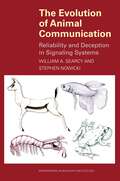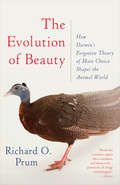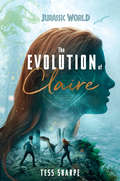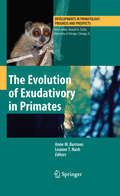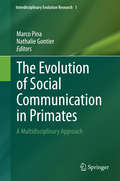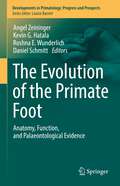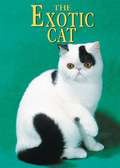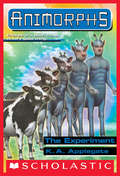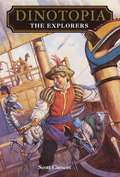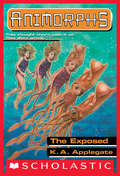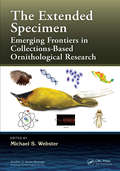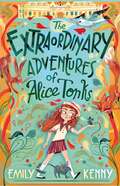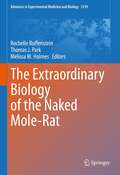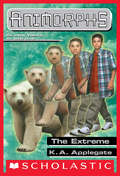- Table View
- List View
The Evolution of Animal Communication: Reliability and Deception in Signaling Systems (Monographs in Behavior and Ecology #30)
by Stephen Nowicki William A. SearcyGull chicks beg for food from their parents. Peacocks spread their tails to attract potential mates. Meerkats alert family members of the approach of predators. But are these--and other animals--sometimes dishonest? That's what William Searcy and Stephen Nowicki ask in The Evolution of Animal Communication. They take on the fascinating yet perplexing question of the dependability of animal signaling systems. The book probes such phenomena as the begging of nesting birds, alarm calls in squirrels and primates, carotenoid coloration in fish and birds, the calls of frogs and toads, and weapon displays in crustaceans. Do these signals convey accurate information about the signaler, its future behavior, or its environment? Or do they mislead receivers in a way that benefits the signaler? For example, is the begging chick really hungry as its cries indicate or is it lobbying to get more food than its brothers and sisters? Searcy and Nowicki take on these and other questions by developing clear definitions of key issues, by reviewing the most relevant empirical data and game theory models available, and by asking how well theory matches data. They find that animal communication is largely reliable--but that this basic reliability also allows the clever deceiver to flourish. Well researched and clearly written, their book provides new insight into animal communication, behavior, and evolution.
The Evolution of Beauty: How Darwin's Forgotten Theory of Mate Choice Shapes the Animal World - and Us
by Richard O. PrumA FINALIST FOR THE PULITZER PRIZENAMED A BEST BOOK OF THE YEAR BY THE NEW YORK TIMES BOOK REVIEW, SMITHSONIAN, AND WALL STREET JOURNALA major reimagining of how evolutionary forces work, revealing how mating preferences—what Darwin termed "the taste for the beautiful"—create the extraordinary range of ornament in the animal world. In the great halls of science, dogma holds that Darwin's theory of natural selection explains every branch on the tree of life: which species thrive, which wither away to extinction, and what features each evolves. But can adaptation by natural selection really account for everything we see in nature? Yale University ornithologist Richard Prum—reviving Darwin's own views—thinks not. Deep in tropical jungles around the world are birds with a dizzying array of appearances and mating displays: Club-winged Manakins who sing with their wings, Great Argus Pheasants who dazzle prospective mates with a four-foot-wide cone of feathers covered in golden 3D spheres, Red-capped Manakins who moonwalk. In thirty years of fieldwork, Prum has seen numerous display traits that seem disconnected from, if not outright contrary to, selection for individual survival. To explain this, he dusts off Darwin's long-neglected theory of sexual selection in which the act of choosing a mate for purely aesthetic reasons—for the mere pleasure of it—is an independent engine of evolutionary change. Mate choice can drive ornamental traits from the constraints of adaptive evolution, allowing them to grow ever more elaborate. It also sets the stakes for sexual conflict, in which the sexual autonomy of the female evolves in response to male sexual control. Most crucially, this framework provides important insights into the evolution of human sexuality, particularly the ways in which female preferences have changed male bodies, and even maleness itself, through evolutionary time. The Evolution of Beauty presents a unique scientific vision for how nature's splendor contributes to a more complete understanding of evolution and of ourselves.
The Evolution of Claire (Jurassic World)
by Tess SharpeDon't miss this pulse-pounding prequel to the Jurassic World movies that reveals the never-before-seen backstory of beloved film character Claire Dearing.Freshman year in college is full of obstacles--there are messy roommates, cranky professors, and disgusting dining halls. But for Claire Dearing, add "How to properly avoid being eaten by a dinosaur" to that list.The year is 2004, and Claire has been given the chance of a lifetime: the opportunity to intern at the Jurassic World theme park less than a year before it opens to the public. She is laser-focused, with her sights set on bettering the lives of all animals worldwide. But life at the park isn't all test-driving gyrospheres and falling head over heels for a fellow student named Justin . . . though she does that too. Rumors and suspicions flood the island, and Claire is determined to unravel the truth.As Claire searches for answers, she and Justin find themselves thrust into a sinister plot that will leave Claire forever changed, forcing her to question everything she thought she knew and bringing her one step closer to the Claire viewers met in Jurassic World and who they'll return to in Jurassic World: Fallen Kingdom.
The Evolution of Exudativory in Primates
by Anne M. Burrows Leanne T. NashThis volume covers aspects of primate exudativory, one of the least common dietary niches among primates. While all primates are generally omnivorous animals, most species, depending on body size, acquire the majority of their energy from fruit, leaves or insects and the majority of their protein from insects or leaves. However, some specialize their caloric intake around the acquisition, processing, and break-down of exudates, the saps and gums produced by trees in response to mechanical or insect damage. Compared to leaves, insects or fruits, these compounds have a unique combination of challenges to the dentition for acquisition and processing and to the gut for digestion. This volume brings together our current knowledge on the morphological, physiological, and evolutionary aspects of being a primate exudativore and to fit these into an evolutionary context. Included in this work are comparisons to marsupial exudates-feeders and the chemical characteristics of exudates.
The Evolution of Feathers: From Their Origin to the Present (Fascinating Life Sciences)
by Christian Foth Oliver W. M. RauhutFeathers are one of the most unique characteristics of modern birds and represent the most complex and colourful type of skin derivate within vertebrates, while also fulfilling various biological roles, including flight, thermal insulation, display, and sensory function. For years it was generally assumed that the origin of flight was the main driving force for the evolution of feathers. However, various discoveries of dinosaur species with filamentous body coverings, made over the past 20 years, have fundamentally challenged this idea and produced new evolutionary scenarios for the origin of feathers. This book is devoted to the origin and evolution of feathers, and highlights the impact of palaeontology on this research field by reviewing a number of spectacular fossil discoveries that document the increasing morphological complexity along the evolutionary path to modern birds. Also featuring chapters on fossil feather colours, feather development and its genetic control, the book offers a timely and comprehensive overview of this popular research topic.
The Evolution of Social Communication in Primates
by Marco Pina Nathalie GontierHow did social communication evolve in primates? In this volume, primatologists, linguists, anthropologists, cognitive scientists and philosophers of science systematically analyze how their specific disciplines demarcate the research questions and methodologies involved in the study of the evolutionary origins of social communication in primates in general and in humans in particular. In the first part of the book, historians and philosophers of science address how the epistemological frameworks associated with primate communication and language evolution studies have changed over time and how these conceptual changes affect our current studies on the subject matter. In the second part, scholars provide cutting-edge insights into the various means through which primates communicate socially in both natural and experimental settings. They examine the behavioral building blocks by which primates communicate and they analyze what the cognitive requirements are for displaying communicative acts. Chapters highlight cross-fostering and language experiments with primates, primate mother-infant communication, the display of emotions and expressions, manual gestures and vocal signals, joint attention, intentionality and theory of mind. The primary focus of the third part is on how these various types of communicative behavior possibly evolved and how they can be understood as evolutionary precursors to human language. Leading scholars analyze how both manual and vocal gestures gave way to mimetic and imitational protolanguage and how the latter possibly transitioned into human language. In the final part, we turn to the hominin lineage, and anthropologists, archeologists and linguists investigate what the necessary neurocognitive, anatomical and behavioral features are in order for human language to evolve and how language differs from other forms of primate communication.
The Evolution of the Primate Foot: Anatomy, Function, and Palaeontological Evidence (Developments in Primatology: Progress and Prospects)
by Daniel Schmitt Angel Zeininger Kevin G. Hatala Roshna E. WunderlichThe human foot is a unique and defining characteristic of our anatomy. Most primates have grasping, prehensile feet, whereas the human foot stands out as a powerful non-grasping propulsive lever that is central to our evolution as adept bipedal walkers and runners and defines our lineage. Very few books have compiled and evaluated key research on the primate foot and provided a perspective on what we know and what we still need to know. This book serves as an essential companion to “The Evolution of the Primate Hand” volume, also in the Developments in Primatology series. This book includes chapters written by experts in the field of morphology and mechanics of the primate foot, the role of the foot in different aspects of primate locomotion (including but not limited to human bipedalism), the “hard evidence” of primate foot evolution including fossil foot bones and fossil footprints, and the relevance of our foot’s evolutionary history to modern human foot pathology.This volume addresses three fundamental questions: (1) What makes the human foot so different from that of other primates? (2) How does the anatomy, biomechanics, and ecological context of the foot and foot use differ among primates and why? (3) how did foot anatomy and function change throughout primate and human evolution, and why is this evolutionary history relevant in clinical contexts today?This co-edited volume, which relies on the insights of leading scholars in primate foot anatomy and evolution provides for the first time a comprehensive review and scholarly discussion of the primate foot from multiple perspectives. It is accessible to readers at different levels of inquiry (e.g., undergraduate/graduate students, postdoctoral research, other scholars outside of biological anthropology). This volume provides an all-in‐one resource for research on the comparative and functional morphology and evolution of the primate foot.
The Evolutionary Biology of Flies
by Brian Wiegmann David K. YeatesFlies (Dipteria) have had an important role in deepening scientists'understanding of modern biology and evolution. The study of flies has figured prominently in major advances in the fields of molecular evolution, physiology, genetics, phylogenetics, and ecology over the last century. This volume, with contributions from top scientists and scholars in the field, brings together diverse aspects of research and will be essential reading for entomologists and fly researchers.
The Evolutionary Biology of Flies
by Brian Wiegmann David K. Yeates Eds.Flies (Dipteria) have had an important role in deepening scientists'understanding of modern biology and evolution. The study of flies has figured prominently in major advances in the fields of molecular evolution, physiology, genetics, phylogenetics, and ecology over the last century. This volume, with contributions from top scientists and scholars in the field, brings together diverse aspects of research and will be essential reading for entomologists and fly researchers.
The Exile's Journey (Survivors: The Gathering Darkness #5)
by Erin Hunter Julia Green Laszlo KubinyiA loyal dog must make her way alone in this gripping fifth book in the second Survivors series.From Erin Hunter, #1 nationally bestselling author of Warriors, Survivors is full of “wild and wonderful adventure” (Kirkus Reviews; starred review) that will thrill fans of Spirit Animals and Wings of Fire.Storm is in exile—and though she’s finally free of the suspicion of her Packmates, she feels more lost than ever. There are only two dogs she knows will never give up on her: Arrow and his mate, Bella.To find them, Storm must fight through longpaw dangers, Leashed Dogs, and a forbidding pack of wolves, all in search of a place where she might finally belong.
The Exotic Cat (Learning About Cats)
by Joanne MatternDescribes the physical features, habits, history and uses of the Exotic cat breed.
The Experiment (Animorphs #28)
by K. A. ApplegateThe Yeerks have decided to try a little experiment. They've decided that if they can develop a way to make people more "willing" to be infested, they can speed up Earth's invasion. So the Yeerks try to invent a substance that will take away the human ability to make a decision. A substance that will eliminate free will.Now the Animorphs are not only faced with trying to slow down the Yeerks' invasion, but they also have to put an end to the genetic testing on a small group of humans. This time there's only one chance to stop the Yeerks. And if anything goes wrong, it's all over...
The Explorers (Dinotopia Series)
by Scott CiencinLong ago, a group of brave Troodon knights undertook difficult quests to help their fellow Dinotopians. They called themselves the Explorers.
The Exposed (Animorphs #27)
by K. A. ApplegateThe Animorphs have one true ally in their battle against the Yeerks: the sentient androids known as the Chee. So when they discover that the Chee -- including their friend Erek -- are in trouble, they have no choice but to help.But the Chee's problem is much deeper than anything the kids could have imagined. It's hidden in the ocean. So far down that no human has ever travelled there and survived. The Animorphs realize what will happen if Visser Three discovers the valuable secrets of the Chee. One of which is the existence of the Animorphs...
The Exquisite Book of Paper Flower Transformations: Playing with Size, Shape, and Color to Create Spectacular Paper Arrangements
by Livia Cetti&“Equips crafters with the skills for creating individual flowers and larger arrangements while providing a delightful overview on the basics of botany.&” —Publishers Weekly In The Exquisite Book of Paper Flower Transformations, artist Livia Cetti ups the ante with a host of grander and more intricate flowers and projects—more blooms, more petals, stronger stems, and bigger, bolder arrangements! Cetti will teach you how to play with size, shape, color, and texture to create twenty-five vibrant single stems in a variety of natural shapes—globes, spikes, bells, saucers, rectangles, cones, and arcs—including hydrangeas, coral charm peonies, honeysuckles, and paperwhites. Then, you&’ll use these elemental shapes to build the 15 bright, abundant arrangements, including bold wreaths, bountiful bouquets, fantastical gilded wall art, and blooming garlands. Introducing new, never-before-seen techniques for dyeing paper and creating moldable leaves and petals, this gorgeous guide is perfect for crafters of all skill levels interested in making realistic and unique home decor, gifts, accessories, and entertaining essentials. &“Unlike fresh-cut flowers, paper blooms last forever. And if you make them like floral stylist, crafter and creative director Livia Cetti, they might even be mistaken for the real thing. One of the top paper-flower artists in the U.S.&” —House & Home
The Exquisite Butterfly Companion: The Science and Beauty of 100 Butterflies
by American Museum of Natural History Hazel DaviesThis exquisite set, created with the American Museum of Natural History, is the perfect gift for lovers of Lepidoptera! Tucked inside a case with an organza ribbon closure, youll find a field guide with information on 100 species of butterfly and moth, plus an envelope with 100 sheets of paper, each featuring a perforated, full-color picture from the book. Punch them out to create keepsakes that really fly, including beautiful gliders, flyers, and mobile models.
The Extended Specimen: Emerging Frontiers in Collections-Based Ornithological Research (Studies in Avian Biology)
by Michael WebsterThe Extended Specimen highlights the research potential for ornithological specimens, and is meant to encourage ornithologists poised to initiate a renaissance in collections-based ornithological research. Contributors illustrate how collections and specimens are used in novel ways by adopting emerging new technologies and analytical techniques. Case studies use museum specimens and emerging and non-traditional types of specimens, which are developing new methods for making biological collections more accessible and "usable" for ornithological researchers. Published in collaboration with and on behalf of The American Ornithological Society, this volume in the highly-regarded Studies in Avian Biology series documents the power of ornithological collections to address key research questions of global importance.
The Extinct Alphabet Book (Jerry Pallotta's Alphabet Books)
by Jerry PallottaLearn about the five-eyed Opabinia and the Four-toed Horse. Speculate about the life of the Jamaican Long-tongued Bat. Discover the fate of the beautiful Quagga. But don't look for any dinosaurs in this book. There aren't any!Millions of creatures other than dinosaurs are now extinct. In true alphabet book tradition, the author has found twenty-six of the most extraordinary past-inhabitants of the Earth.Jerry Pallotta and Ralph Masiello team up to provide exciting, accurate text and illustrations filled with unusual and amusing insight that will satisfy fans of all ages.
The Extincts
by Roman Muradov Veronica CossanteliGeorge is looking for a job in order to raise money for a new bike, so when he sees a help wanted ad for Wormestall Farm, he goes for it. Before long, he's embroiled in a madcap adventure involving creatures both (supposedly) extinct and (previously thought to be) mythological, a new friend (a girl!), and a maniacal taxidermist who wants the animals of Wormestall Farm in her own private collection . . . stuffed, of course.
The Extraordinary Adventures of Alice Tonks
by Emily Kenny&“Has heart, soul and so much spirit.&” Lindsay Galvin, author of Darwin&’s Dragons &“Disappearing animals, twists and turns, and an amazing autistic protagonist.&” Rashmi Sirdeshpande, author of Dosh &“Exciting, deftly plotted and full of surprises.&” Sinéad O'Hart, author of The Eye of the North &“It&’s not your chips I&’m after, Alice Tonks,&” the seagull said sternly. &“We&’ve got a job for you.&” After a rather strange encounter with a seagull on her first day of boarding school, Alice Tonks is left with a lot of questions. Why does the bird need her help? And WHY can she talk to seagulls? Alice is used to being by herself but she can&’t solve the mystery alone. With new friends behind her, can Alice harness her magic powers and become the hero she never imagined? A story about finding your voice, friendship and unlikely heroes, for fans of A Kind of Spark
The Extraordinary Adventures of Alice Tonks: Longlisted for the Adrien Prize, 2022 (The Extraordinary Adventures of Alice Tonks #1)
by Emily Kenny&“Has heart, soul and so much spirit.&” Lindsay Galvin, author of Darwin&’s Dragons &“Disappearing animals, twists and turns, and an amazing autistic protagonist.&” Rashmi Sirdeshpande, author of Dosh &“Exciting, deftly plotted and full of surprises.&” Sinéad O'Hart, author of The Eye of the North Alice Tonks would love to make friends at boarding school. And, being autistic, she just wants people to accept her for who she is. But after a rather strange encounter with a talking seagull on her first day, she suddenly has a new challenge and a lot of questions. Animals are going missing and Alice can&’t solve the mystery alone. With new friends behind her, can Alice harness her magic powers and become the hero she never imagined? A story about finding your voice, friendship and unlikely heroes, for fans of A Kind of Spark
The Extraordinary Biology of the Naked Mole-Rat (Advances in Experimental Medicine and Biology #1319)
by Rochelle Buffenstein Thomas J. Park Melissa M. HolmesThis volume focuses on the huge advances in the last 25 years on the use of this animal model for biomedical research (cancer, heart disease and neurodegeneration), fundamental neuroscience and basic subterranean biology. In 2013, Science magazine named the naked mole-rat as the Vertebrate of the Year. This was partly due to research carried out documenting its extreme longevity, negligible senescence, and prolonged maintenance of cancer free, good health well into old age as well as seminal work on mechanisms involved in these processes, pain and hypoxia resistance. In addition to this research focus on longevity and chronic diseases such as cancer and cardiovascular disease, the naked mole-rat has also made a substantial contribution to the fields of ecophysiology, neuroscience and behavior. With international contributions, this book provides a valuable text for zoological students, behavioral scientists and biomedical researchers.
The Extraordinary World of Birds (The Magic and Mystery of the Natural World)
by David LindoEnter the world of birds for an incredible journey through the skies, into trees, and even underground.Parrots, hummingbirds, eagles, and more swoop across the pages of this colorful bird book, which combines gorgeous illustrations and photos to help young enthusiasts learn all about the wonderful world of birds. From frozen icescapes to sweltering deserts, from prehistoric ancestors to amazing adaptations, they&’ll discover the surprising homes and habits of our feathered friends. They&’ll also find out about how we can help protect birds and their natural habitats.The Extraordinary World of Birds, illustrated by Claire McElfatrick, takes children on a fascinating journey, showing them just how amazing birds are, what they do for our planet, and how we can help them. It includes bird families such as gamebirds, flightless birds, and perching birds, plus amazing facts on how birds talk to each other, what they eat, how they find partners, and how they are able to fly.
The Extreme (Animorphs #25)
by K. A. ApplegateMarco and the other Animorphs have managed to find out where the Yeerks are planning to build their next ground-based Kandrona. That's a good thing. But the location is supposed to be somewhere near the North Pole. That's a bad thing. The Animorphs know that the Yeerks are a "cold-blooded" species, but this is a little nuts! Who wants to be near the North Pole without Arctic morphs -- and wearing spandex?Even so, the kids know that if the Yeerks succeed with their plan, Earth is pretty much done for. And Marco and the other Animorphs aren't quite ready to give up the fight.
